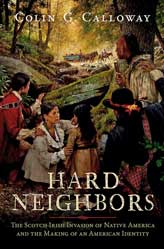 |
 |
|||
Hard Neighbors: The Scotch-Irish Invasion of Native America and the Making of an American Identity |
|||
|
by Colin Calloway |
$35.00 | ||
|
The story this book tells is less about the Scotch-Irish as a distinct ethnic group than as a people in motion who, in collusion and conflict with colonial authorities, repeatedly inserted themselves on Native land. Instead of a tale of unified westward expansion in the 18th and 19th centuries, however, it illuminates the shifting experiences, encounters, and humanity of those enmeshed in the violence of colonialism, acting as buffers between competing powers. Both sweeping and nuanced, the book explores the Scotch-Irish story, separating myth and reality, tracing their experiences as a marginalized and expendable population living between colonial powers and Indigenous peoples, also in motion, and in the process illuminating their roles as protective and disruptive forces. The Scotch-Irish fought Indian wars and shaped the frontier, and their experiences in turn shaped the nation. Expansion, and the accompanying expulsion and killing of Indian people, influenced national attitudes and policies, transforming Native peoples into outsiders on their own land even as it helped to create an identity for those who had been seen as little better. In the process, the Scotch-Irish made a place for themselves, transforming themsevles into "Americans." Hardback, 2024, 528 pp., 6" x 9", b/w illustrations, notes, index, $35.00
Cover image: "Another Broken Treaty" by Robert Griffing. Click HERE for print information. |
|||
|
|
|||
|
©2024 Lord Nelson's
Gallery ~ 717.334.7950 |
|||

 They were at home with the violence inherent to life on the margins of empire. They were the point of the spear of white expansionism and resettlement, the hard edge of colonialism.They were the "Indian killers," "settlers" who invaded "Indian country." Those are the outlines of the people who came to be known as "Scotch-Irish": fierce and uncivilized whom the British had sent first to settle the borderlands in the north of Ireland and then across the Atlantic to inhabit the borderlands of the growing American colonies. The terms are as contested as the land on and for which they fought.
They were at home with the violence inherent to life on the margins of empire. They were the point of the spear of white expansionism and resettlement, the hard edge of colonialism.They were the "Indian killers," "settlers" who invaded "Indian country." Those are the outlines of the people who came to be known as "Scotch-Irish": fierce and uncivilized whom the British had sent first to settle the borderlands in the north of Ireland and then across the Atlantic to inhabit the borderlands of the growing American colonies. The terms are as contested as the land on and for which they fought. 